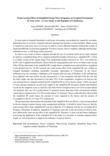Water-saving Effect of Simplified Surge Flow Irrigation on Irrigated Farmlands in Arid Areas - A Case Study in the Republic of Uzbekistan -
JIRCAS Working Report
| ISSN | 1341710X |
|---|---|
| 書誌レコードID(総合目録DB) | AA11159468 |

本文フルテキスト
jircas_working_report88-_33-49.pdf664.89 KB
In some parts of irrigated farmlands in arid areas, decreasing crop productivity caused by secondary salinization due to excessive irrigation and poor drainage has become a serious problem. Water saving is required in such areas, but it is not easy to shift to a more efficient irrigation method due to lack of funds and difficulty in procuring equipment. For these reasons, furrow irrigation, although causing large infiltration losses, is still being widely practiced. In order to save water in furrow irrigation through the use of a method which can be easily adopted by farmers, a simplified Surge Flow irrigation method (hereinafter referred to as ‘simplified SF’), which is a simple version of the regular Surge Flow method (hereinafter referred to as ‘SF’), was contrived. In SF, water is applied intermittently, about 4 times by using pipelines and valves, to obtain water-saving effect. On the other hand, in the simplified SF, a single furrow irrigation (conventional furrow irrigation) is just divided into two. In this research, the water-saving effect of the simplified SF was verified on irrigated farmlands exhibiting remarkable secondary salinization in Uzbekistan. In the furrow infiltration test, the cumulative infiltration at 60 minutes after the start of flooding, in the soil that has been supplied with water before one day, decreased by 9.5 mm compared with that of the dry soil; and the basic intake rate also decreased to less than 50%. In the comparative irrigation test between the conventional furrow irrigation method and the simplified SF on 100 m furrow (slope: 1/800), the speed of water advance during the second water supply by the simplified SF increased, and the total duration it took for the irrigation water to reach the end of the furrow (irrigation time) was 6,026 seconds (about 100 minutes); this was 742 seconds (about 13 minutes) shorter than that of the conventional method, which had an irrigation time of 6,768 seconds (about 113 minutes). These results therefore showed that the simplified SF could reduce the amount of water supplied to the furrow and the amount of oversupplied water by 11% and 15%, respectively.
This present study demonstrates the potential of the simplified SF as an effective water-saving method in the developing countries facing water management problems. It should be noted, however, that the water-saving effect of the simplified SF was lower than the 21% obtained with the use of regular SF in Fergana, Uzbekistan. In addition, stagnation of irrigation water due to the unevenness of furrows may have affected the water-saving effect of the simplified SF. Therefore, to deal with the future challenges concerning the application of the simplified SF in the field, it is necessary to consider optimal furrow length, as well as measures to suppress the influence of uneven furrows.
This present study demonstrates the potential of the simplified SF as an effective water-saving method in the developing countries facing water management problems. It should be noted, however, that the water-saving effect of the simplified SF was lower than the 21% obtained with the use of regular SF in Fergana, Uzbekistan. In addition, stagnation of irrigation water due to the unevenness of furrows may have affected the water-saving effect of the simplified SF. Therefore, to deal with the future challenges concerning the application of the simplified SF in the field, it is necessary to consider optimal furrow length, as well as measures to suppress the influence of uneven furrows.
| 刊行年月日 | |
|---|---|
| 作成者 | Junya ONISHI Hiroshi IKEURA Isamu YAMANAKA Yoshinobu KITAMURA Haruyuki FUJIMAKI |
| 著者キーワード | Salt accumulation Furrow irrigation Water-saving irrigation Simplified Surge Flow irrigation method Republic of Uzbekistan |
| 巻 | 88 |
| 開始ページ | 33 |
| 終了ページ | 49 |
| 関連するリソース | 部分である : JIRCAS Working Report no.88 |
| 言語 | eng |
関連する刊行物
部分である
